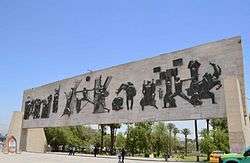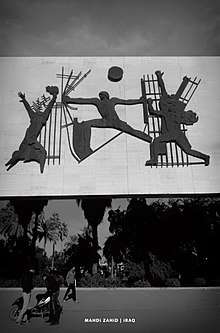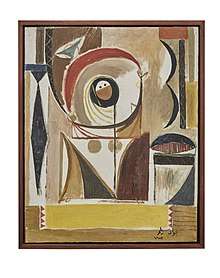Jawad Saleem
Jewad Selim (1919–1961) (Arabic: جواد سليم) was an Iraqi painter and sculptor[1] born in Ankara (Turkey) in 1919.[2] He became an influential artist through his involvement with the Iraqi Baghdad Modern Art Group, which encouraged artists to explore techniques that combined both Arab heritage and modern art forms. He is considered to be one of Iraq's greatest 20th-century sculptors.
Jawad Saleem | |
|---|---|
جواد سليم | |
 Jawad Saleem | |
| Born | Jawad bin Mohammed Salim bin Abdul Qadir al-Khalidi 1919 |
| Died | 23 January, 1961 (aged 42 years) Iraqi Republic |
| Nationality | Iraqi |
| Education | Paris (1938-1939), Rome (1939-1940), London (1946-1948) |
| Known for | Painter and sculptor |
Notable work | Nasb al-Hurriyah (Monument of Freedom), Baghdad |
| Movement | The Baghdad Modern Art Group; One Dimension Group |
| Spouse(s) | Lorna Saleem |
Life and career
Jawad Saleem was born in Ankara, Turkey into a middle-class family.[3] His parents were both originally from Mosel in Northern Iraq,[4] and his father, Mohammed Hajji Selim was a military officer who had been stationed in Ankara at the time of Saleem's birth,[5] but returned to Baghdad in the 1920s, when the children were relatively young.[6] His father was an amateur artist, his mother was an artist and a skilled embroiderer and his brothers, Saud and Nizarre along with his sister, Naziha Salim all became artists.[7]
Jawad Saleem studied sculpture in Paris (1938-1939) on a scholarship, but his studies were interrupted by the outbreak of war. [8] He relocated to Rome (1939-1940), but again his studies were interrupted by war, forcing him to return to Baghdad. At war's end, he enrolled at the Slade School, London (1946-1948),[1] [9] where he was heavily influenced by Western artists such as Pablo Picasso and Henry Moore.[1] In England, he met an artist, Lorna, a native of Sheffield, and the pair were married in 1950.[10]
During the hiatus in his studies, Saleem was employed at the Directorate of Antiquities in Baghdad between 1940–1945 and was appointed head of the Sculpture Department at the Institute of Fine Arts in Baghdad, a position he retained until his death in 1961.[11] His work exposed him to Iraq's ancient art traditions, and he consciously sought to discover the possibilities of combining ancient motifs with within the modern abstract art he had observed in Europe.[12] His wife, Lorna Saleem, noted that he was fascinated with ancient Egyptian and Mesopotamian sculptures. She explained:[13]
"His aim was to create an artistic language, unique to Iraq, built on the great art of its past civilizations, Sumer, Babel, Assyria and of course, Islam, but in the language of the 20th century.
He is generally credited with being the first Iraqi artist to draw on his heritage and guide local artists towards a distinctly Iraqi style.[14]
Iraq in the 1930s had few art museums or galleries. Accordingly, Saleem's first solo exhibition was held in the private home of prominent Iraqi architect, Mohamed Makiya.[15] In 1944, he was invited to work with historical masterpieces and to assist archaeologists in any restoration work that was necessary. These encounters with ancient heritage fostered a strong sense of pride in Iraq's ancient art heritage and questions about the nexus between 'heritage' and 'contemporary' art which would preoccupy the artist and philosopher for the rest of his working life.[16]
In 1951, he gave a public lecture in which he spoke critically and bitterly about public taste in Iraq. For this, Saleem became known as an 'enemy of the people.' Yet within two decades, Saleem was praised by the Iraqi elite and his reputation was mythologised by poets and writers.[17]
He was one of the founders of the Jama'et Baghdad lil Fen al-Hadith (The Baghdad Modern Art Group, founded in 1951) with fellow artist Shakir Hassan Al Said and Mohammed Ghani Hikmat (1929-2011);[1] a group which attempted to combine ancient Iraqi art traditions with modern European techniques. The group's mantra, was istilham al-turath – seeking inspiration from tradition.[18] Saleem, along with al-Said and other members of the Modern Baghdad group were inspired by the 13th-century Baghdad School and the work of ancient calligraphers and illustrators such as Yahya Al-Wasiti who was active in Baghdad in the 1230s. They believed that the Mongol invasion of 1258 represented a "break in the chain of pictorial Iraqi art"[19] and wanted to recover lost traditions.[20] After the death of Saleem in 1961, al-Said headed the group.[21] This group accomplished a great deal in terms of popularising modern art by giving Iraqis a sense of national pride in their ancient art heritage.[22]
Saleem first came to the attention of international audiences in 1952 when his competition entry, The Unknown Political Prisoner was one of 80 selected out of 3,500 entries for exhibition at the Tate Gallery in London and was the only Arab artist to be included in the exhibition. The following year he toured the United States and his work was well received.[23]
Although he worked both as a painter and sculptor, he always had misgivings about practising both simultaneously. Towards the end of the 1950s, he made the decision to focus exclusively on sculpture.[24]
In 1959, shortly after Iraq gained independence, Saleem was commissioned by the new leader of the republic, Brigadier General 'Abd al-Karim Qasim to create a monument for the city centre that would be a celebration to Iraq's declaration of independence. It was to be situated in the heart of Baghdad's central business district, overlooking Liberation Square and Jamhouriyya Bridge. The sculptor understood that the monument would need to be a symbol of a new world, and designed a work that was a narrative of the 1958 revolution, but that also paid homage to Iraq's deep art history by including Abassid and Babylonian wall-reliefs, producing a sculpture that was both "strikingly modern" yet also referenced tradition.[25]

Saleem laboured on the project under difficult conditions, resisting all attempts by Qasim to have his image incorporated.[26] Initially, Saleem had wanted the sculpture to be at ground level, but the architect, Rifa'at Chadirchi insisted that it be elevated so that it would look more 'monumental'. As a result, the completed work faces the busy traffic rather than people walking in the adjacent gardens. Although the monument was Saleem's design, he did not see it through to completion; following his premature death, the project was completed in 1961 by Saleem's friend, Mohammed Ghani Hikmat, who had previously been assisting on the project by casting the bronze figures.[27] The completed monument, known as Nasb al-Hurriyah (Monument of Freedom), has survived various attempts to have it pulled down and is one of Baghdad's most iconic public works.[28]
Saleem is credited as being the most influential artist in Iraq's modern art movement[2] and is said to have brought a 'modern vision' to Iraq.[29] The Iraqi intellectual, Jabra Ibrahim Jabra wrote of him:
"No single artist has had so much influence on art in Iraq...an influence that has in time overflowed Iraq's borders to the rest of the Arab world."[30]
Saleem suffered a heart attack and died in the Republican Hospital on 23 January, 1961 aged 42 years. His wife, Lorna was with him, and he was surrounded by his friends from the arts community; Hafidh al-Droubi, Ismail al-Sheikhli, Said Shaker, Mohammed Abdel Wahab, Bahir Faeq, Salem Damluji and Khalid Al-Qasab as well as his former student and colleague, Khaled al-Rahal who was reduced to tears and made a death mask of his mentor, the man to whom he had been utterly devoted during his lifetime. [31] Scholars have suggested that his premature death can be attributed, at least in part, to the stresses of completing the Nasb al-Hurriyah sculpture. His demise was seen as an "irreparable loss to Arab visual culture."[32]
Work

Saleem consciously included Assyrian and Babylonian architectural features into his artworks - and was one of the first Iraqi artists to forge links with Iraq's ancient civilisations and their artistic traditions.[33]
Examples of his work are held in the Jordan National Gallery of Fine Art.[34] Saleem is especially known for his Nasb al-Hurriyah, located in Tahir Square, one of the main squares in Baghdad's city centre.[35] The monument consists of 14 bronze castings, representing 25 figures on a travertine slab, raised 6 metres off the ground. It provides a narrative of the 1958 Revolution of Iraq with references to Iraqi history by incorporating Assyrian and Babylonian wall-reliefs.[36] It is meant to be read as a verse of Arabic poetry - from right to left - beginning with events that preceded the revolution - and concluding with harmony following independence.[37] The sculpture featured on the 10,000 dinar bank note for 2013-2015 in his honour.[38] The multiple references and hidden layers of meaning in the work inspired Arab artists across the region and encouraged them to pursue artwork with a national identity at a time when many Arab nations were attaining independence.[39]
Notable public works
Notable smaller sculptures
Select list of paintings

- The Baghdadi Family, 1953
- Children Playing, oil on canvas, 1953-54
- Hilal Decoration, 1955
- Al-Zafa, 1956
- Musicians in the Street, 1956
- Baghdadiat, 1957
- Kid Women, 1957
- A Woman and a Girl, 1957
- Henna Night, 1957
- Seedling Seller, 1957
- Woman Adorned, 1957
- Two Boys Eating al-Raqi (watermelons), 1958 (This work can be seen hanging on the wall in the portrait of Saleem picture above.)
- The Girl and the Gardener, 1958
- Siesta, 1958
- The Dead Tree, 1958
- Girl and Dove, 1958
- Mosque of Kufa, 1958
- Tailoring, 1958
- In the Forum of the Caliph, 1958
- Woman with Coffee Pot, watercolour, private collection, date unknown[44]
See also
References
- "Jewad Selim". www.encyclopedia.mathaf.org. Retrieved 2016-04-22.
- "Bonhams: Jewad Selim (Iraq, 1919-1961) Young Man and his Wife". www.bonhams.com. Retrieved 2016-04-22.
- Ghareeb, E.A. and Dougherty, B., Historical Dictionary of Iraq, Scarecrow Press, 2004, p. 207
- Shabout, N. (ed), A Century of Iraqi Art, Bonham's of London, 2015 [Illustrated Catalog to accompany sale, Monday 20 April 2015
- Metcher-Atassi, S., "Munif's Interest in Modern Art, Friendship, Symbolic Exchange and the Art of the Book," The MIT Electronic Journal of Middle Easern Studies, Spring, 2007, pp 99-116
- Shabout, N. (ed), A Century of Iraqi Art, Bonham's of London, 2015 [Illustrated Catalog to accompany sale, Monday 20 April 2015
- Ministry of Culture, Iraq, Culture and Arts in Iraq: Celebrating the Tenth Anniversary of the July 17-30 Revolution, Iraq, Ministry of Culture and Arts, 1978, p. 23
- Tejel, J., Writing the Modern History of Iraq: Historiographical and Political Challenges, World Scientific, 2012, p. 476
- Jabra, J.I., Art in Iraq Today, London, Embassy of the Republic of Iraq, 1966, p. 1 Online:
- Ibrahimi Collection, Online:
- Shabout, N., "Jewad Selim: On Abstraction and Symbolism," in Mathaf Encyclopedia of Modern Art and the Arab World, Online:
- Ali, W., Modern Islamic Art: Development and Continuity, University of Florida Press, 1997, p.45
- Cited in: Bashkin, O., The Other Iraq: Pluralism and Culture in Hashemite Iraq, Stanford University Press, 2008, p. 131
- Zuhur, S. (ed.), Colors of Enchantment: Theater, Dance, Music, and the Visual Arts of the Middle East, I.B.Tauris, 2001, p. 390
- Sabrah,S.A. and Ali, M.," Iraqi Artwork Red List: A Partial List of the Artworks Missing from the National Museum of Modern Art, Baghdad, Iraq, 2010, p. 10
- Stone, P.G. and Bajjaly, J.G., The Destruction of Cultural Heritage in Iraq, Boydell & Brewer Ltd, 2008, p. 293
- Al-Khalil, S. and Makiya, K., The Monument: Art, Vulgarity, and Responsibility in Iraq, University of California Press, 1991, p. 80
- Shabout, N., "Jewad Selim: On Abstraction and Symbolism," in Mathaf Encyclopedia of Modern Art and the Arab World, Online: http://www.encyclopedia.mathaf.org.qa/en/essays/Pages/Jewad-Selim,-On-Abstraction-and-Symbolism.aspx
- Shabout, N., "Jewad Selim: On Abstraction and Symbolism," in Mathaf Encyclopedia of Modern Art and the Arab World, Online
- Ulrike al-Khamis, “An Historical Overview 1900s-1990s,” in: Maysaloun, F. (ed.), Strokes of Genius: Contemporary Iraqi Art, London:, Saqi Books, 2001, p. 25; Baram, A., Culture, History and Ideology in the Formation of Ba'thist Iraq,1968-89, Springer, 1991, pp 70-71
- Shabout, Nada M. (2007). Dafatir. University of North Texas School of Visual Arts. p. 16. ISBN 978-1-889886-08-4.
- Al-Khalil, S. and Makiya, K., The Monument: Art, Vulgarity, and Responsibility in Iraq, University of California Press, 1991, p. 80
- Al-Khalil, S. and Makiya, K., The Monument: Art, Vulgarity, and Responsibility in Iraq, University of California Press, 1991, p. 95
- Ali, W., Modern Islamic Art: Development and Continuity, University of Florida Press, 1997, p. 45; Shabout, N.M., Modern Arab Art: Formation of Arab Aesthetics, University of Florida Press, 2007, p. 29
- Al-Khalil, S. and Makiya, K., The Monument: Art, Vulgarity, and Responsibility in Iraq, University of California Press, 1991, p. 83
- Al-Khalil, S. and Makiya, K., The Monument: Art, Vulgarity, and Responsibility in Iraq, University of California Press, 1991, p. 82
- Greenberg, N., "Political Modernism, Jabrā, and the Baghdad Modern Art Group," CLCWeb: Comparative Literature and Culture, Vol. 12, No. 2, 2010, Online: https://docs.lib.purdue.edu/cgi/viewcontent.cgi?article=1603&context=clcweb, DOI: 10.7771/1481-4374.160; Floyd, T., "Mohammed Ghani Hikmat," [Biographical Notes] in: Mathaf Encyclopedia of Modern Art and the Islamic World, Online: http://www.encyclopedia.mathaf.org.qa/en/bios/Pages/Mohammed-Ghani-Hikmat.aspx
- Dabrowska, K. and Hann, G., Iraq Then and Now: A Guide to the Country and Its People, Bradt Travel Guides, 2008, p. 215
- Stone, P.G. and Bajjaly, J.G., The Destruction of Cultural Heritage in Iraq, Boydell & Brewer Ltd, 2008, p. 293
- Cited in: Greenberg, N., "Political Modernism, Jabrā, and the Baghdad Modern Art Group," CLCWeb: Comparative Literature and Culture, Vol. 12, No. 2, 2010, Online: https://docs.lib.purdue.edu/cgi/viewcontent.cgi?article=1603&context=clcweb, DOI: 10.7771/1481-4374.160
- Aal-Qasab, "Jawad Salim is Running Behind the Horizon," Al Iraq, Online:
- Al-Khalil, S. and Makiya, K., The Monument: Art, Vulgarity, and Responsibility in Iraq, University of California Press, 1991, p. 95
- Kohl, P.L. Kozelsky, M., Ben-Yehuda, N. (eds), Selective Remembrances: Archaeology in the Construction, Commemoration, and Consecration of National Pasts, University of Chicago Press, 2008, pp 199-200
- al- Matḥaf al-Waṭanī al-Urdunnī lil-Funūn al-Ǧamīla and Wiǧdān ʻAlī, Jordan National Gallery of Fine Arts, 2005, p. 251
- Reynolds, D.F., The Cambridge Companion to Modern Arab Culture,Cambridge University Press, 2015, p. 199
- Dabrowska, K. and Hann, G., Iraq Then and Now: A Guide to the Country and Its People, Bradt Travel Guides, 2008, p. 215; Kohl, P.L., Kozelsky, M. and Ben-Yehud, N., Selective Remembrances: Archaeology in the Construction, Commemoration, and Consecration of National Pasts, University of Chicago Press, 2008, p.200
- Al-Khalil, S. and Makiya, K., The Monument: Art, Vulgarity, and Responsibility in Iraq, University of California Press, 1991, pp 82-83
- Coinweeek, 24 June, 2017, Online: https://coinweek.com/paper-money-2/iraqi-10000-dinar-note-mosque-destroyed-isis/
- Reynolds, D.F., The Cambridge Companion to Modern Arab Culture,Cambridge University Press, 2015, p. 200
- Myers, S.K., "Iraq’s Modern Art Collection, Waiting to Re-emerge," New York Times, 13 July, 2010, Online:
- Greenberg, N., "Political Modernism, Jabrā, and the Baghdad Modern Art Group," CLCWeb: Comparative Literature and Culture, Vol. 12, No. 2, 2010, Online: https://docs.lib.purdue.edu/cgi/viewcontent.cgi?article=1603&context=clcweb, DOI: 10.7771/1481-4374.160; Floyd, T., "Mohammed Ghani Hikmat," [Biographical Notes] in: Mathaf Encyclopedia of Modern Art and the Islamic World, Online: http://www.encyclopedia.mathaf.org.qa/en/bios/Pages/Mohammed-Ghani-Hikmat.aspx
- Ali, W., Modern Islamic Art: Development and Continuity, University of Florida Press, 1997, pp 28-29
- Al-Khalil, S. and Makiya, K., The Monument: Art, Vulgarity, and Responsibility in Iraq, University of California Press, 1991, pp 72-98
- Ali, W., Modern Islamic Art: Development and Continuity, University of Florida Press, 1997, p. 146
Parts of this article have been translated from the Arabic Wikipedia.
External links
- Modern Art Iraq Archive Electronic resource maintained by Iraqi artists to preserve Iraq's art heritage and includes reproductions of artworks, many of which were looted from the Museum of Modern Art in 2003 and remain missing. These works are not accessible in any other public source.
Further reading
- Ali, W., Modern Islamic Art: Development and Continuity, University of Florida Press, 1997
- Shabout, N.M., Modern Arab Art: Formation of Arab Aesthetics, University of Florida Press, 2007
- Bloom J. and Blair, S., The Grove Encyclopedia of Islamic Art and Architecture, Oxford University Press, 2009 Vols 1-3
- Reynolds, D.F. (ed.), The Cambridge Companion to Modern Arab Culture, Cambridge University Press, 2015 ( Or Khoury, N.N.N. "Art" in Dwight, F. Reynolds (ed.), The Cambridge Companion to Modern Arab Culture, Cambridge University Press, 2015, pp 191-208
- Faraj, M., Strokes Of Genius: Contemporary Art from Iraq, London, Saqi Books, 2001
- Schroth, M-A. (ed.), Longing for Eternity: One Century of Modern and Contemporary Iraqi Art, Skira, 2014
- Bahrani, Z. and Shabout, N.M., Modernism and Iraq, Miriam and Ira D. Wallach Art Gallery and Columbia University, 2009
- "Iraq: Arts" Encyclopedia Britannica, Online: